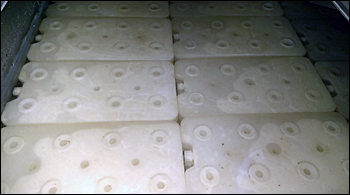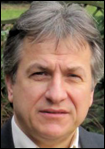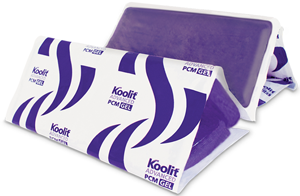 The Phase Change Matters e-mail newsletter is a weekly summary of the latest news and research on phase change materials and thermal energy storage. To subscribe, visit www.puretemp.com/subscribe. For more frequent updates, follow @puretemp on Twitter or visit the Phase Change Matters blog, www.puretemp.com/pcmatters.
The Phase Change Matters e-mail newsletter is a weekly summary of the latest news and research on phase change materials and thermal energy storage. To subscribe, visit www.puretemp.com/subscribe. For more frequent updates, follow @puretemp on Twitter or visit the Phase Change Matters blog, www.puretemp.com/pcmatters.
ENERGY STORAGE
PCM system inefficiencies blamed on design flaws, operator errors
A PCM-based thermal energy storage system installed in an 11-story building at an Australian university used just 15 percent of its heat storage capacity to shift peak cooling load, according to researchers who monitored system performance for 25 months.
 A team led by Morshed Alam of Swinburne University of Technology in Hawthorn found that the PCM reduced chiller cooling load by 12 to 37 percent in winter but remained inactive in summer, partly because the ambient temperature was not cold enough to charge the PCM tank. The tank was designed to reduce the daytime cooling load on the chiller by 33 percent.
A team led by Morshed Alam of Swinburne University of Technology in Hawthorn found that the PCM reduced chiller cooling load by 12 to 37 percent in winter but remained inactive in summer, partly because the ambient temperature was not cold enough to charge the PCM tank. The tank was designed to reduce the daytime cooling load on the chiller by 33 percent.
The results of the study are reported in “Energy saving performance assessment and lessons learned from the operation of an active phase change materials system in a multi-storey building in Melbourne,” published in Applied Energy earlier this year.
“The factors that contributed to the underperformance of active PCM system,” the researchers concluded, “include mismatch between designed and actual operation of the PCM system, inefficient operation logic of the system, poor material quality, and limited knowledge of maintenance staffs during the operation stage.”
 The TES system, installed in the 11th floor of Swinburne’s Advanced Manufacturing and Design Centre, completed in 2015, was designed to minimize the daytime cooling load on the chiller and increase the building energy efficiency. The system includes a 5x4x2-meter tank filled with 5,120 FlatIce PCM panels made by PCM Products Ltd. Each HDPE panel is 500x250x45 mm and is filled with a salt hydrate PCM with the melting temperature of 13-15 °C. Water is used as the heat transfer fluid.
The TES system, installed in the 11th floor of Swinburne’s Advanced Manufacturing and Design Centre, completed in 2015, was designed to minimize the daytime cooling load on the chiller and increase the building energy efficiency. The system includes a 5x4x2-meter tank filled with 5,120 FlatIce PCM panels made by PCM Products Ltd. Each HDPE panel is 500x250x45 mm and is filled with a salt hydrate PCM with the melting temperature of 13-15 °C. Water is used as the heat transfer fluid.
The researchers reported two problems with the PCM: a “very high degree of supercooling” that slowed the solidification process and a measured latent heat capacity (53 joules per gram) that was much lower than the manufacturer’s specification (160 J/g).
Alam, a senior research fellow at Swinburne’s Centre for Sustainable Infrastructure, Department of Civil and Construction, answered a few questions about the research in an email interview.
Q: This the first comprehensive report I’ve seen that analyzes the actual performance of a PCM/TES system in a commercial building. Do you know of others? For example, has the TES system at Melbourne CH2 undergone this kind of analysis?
A: “I am aware of the PCM system installed in CH2 building in Melbourne. But no such study was carried out to understand the performance of the system. The system went out of order within 5-6 years.”
Q: Any theory on why the PCM’s thermal storage capacity of 53 J/g, as measured using differential scanning calorimetry, did not match the manufacturer’s specified capacity of 160 J/g?
A: “The DSC test is widely used by the researchers around the world to test PCM capacity. But it may not be an appropriate approach to test PCM thermal energy storage capacity. That is why we are now in the process of conducting an experimental study where 6 degree Celsius chilled water will be supplied in a small PCM tank. We will measure the flow rate, melting and solidification temperature and time required to completely solidify and melt the PCM. Based on the result we will optimize the system.”
Q: Have the researchers’ recommendations been put into practice?
A: “We are now working with our facilities department to put the recommendations in practice. We need to finish the optimization and cost-benefit analysis study. Then we can define the ideal operating condition of PCM in this building. We will be able integrate those maybe before next summer in Australia.”
I shared results of the paper with Zafer Ure of PCM Products Ltd. and asked him to comment on the authors’ observations on supercooling and specified-vs-measured latent heat capacity.
 “We have been supplying the same PCM for the last 20 years and many of the installations are 10~15 MWh levels,” Ure wrote. “You cannot use the DSC machine to work out the latent heat for sulphate-based hydrated salts, it only picks up one of the chemicals in the mixture and gives you the data for that chemical. This is a well-known handicap for the DSC application for sulphate-based PCM testing. Moreover, DSC sample is less than gram quantities and this is a mixture of multiple salts, nucleating agent, stabilizers and thickening agent so if you do not pick up the correct mixture, which is very difficult unless you pick it up from the reactor vessel while you are making the PCM (i.e. while the agitators and mixers working at the correct temperature (some salts crystallize at room temperatures), you may not be able to pick up true sample.
“We have been supplying the same PCM for the last 20 years and many of the installations are 10~15 MWh levels,” Ure wrote. “You cannot use the DSC machine to work out the latent heat for sulphate-based hydrated salts, it only picks up one of the chemicals in the mixture and gives you the data for that chemical. This is a well-known handicap for the DSC application for sulphate-based PCM testing. Moreover, DSC sample is less than gram quantities and this is a mixture of multiple salts, nucleating agent, stabilizers and thickening agent so if you do not pick up the correct mixture, which is very difficult unless you pick it up from the reactor vessel while you are making the PCM (i.e. while the agitators and mixers working at the correct temperature (some salts crystallize at room temperatures), you may not be able to pick up true sample.
“They took the sample out of one of the containers and no idea where and how they took the sample. If you do not have the true sample, especially lack of nucleating agent in the very small gram quantity sample, you can get it very wrong data as this is the case for their DSC. We would not ship any PCM unless QA release the goods and our records show the product supplied was within the standard capacity level. The actual latent heat can only be established using air test and actual freeze and melt profiles.
“If they managed to charge and discharge the tank fully they would have measured the tank performance which would have shown the true TES capacity. Sounds like their chilled water design and control did not allow that and therefore there is no way of evaluating the TES tank performance.”
PATENTS
Gel comprising a phase change material
U.S. patent application 20190085226 (applicant Cold Chain Technologies Inc., Franklin, Mass.):
 “Gel including a phase-change material and a gelling agent. In one embodiment, the phase-change material may be n-tetradecane, n-hexadecane or mixtures thereof. The gelling agent may be a high molecular weight styrene-ethylene-butylene-styrene (SEBS) triblock copolymer with a styrene:rubber ratio of about 30:70 to 33:67% by weight. To form the gel, the phase-change material and the gelling agent may be mixed at an elevated temperature relative to room temperature to partially, but not completely, dissolve the gelling agent. The mixture may then be cooled to room temperature. Alternatively, the phase-change material and the gelling agent may be mixed at room temperature, and the mixture may then be heated to form a viscoelastic liquid, which is then cooled to room temperature. The invention is also directed at a method of preparing the gel, a thermal exchange implement including the gel, and a method of preparing the thermal exchange implement.”
“Gel including a phase-change material and a gelling agent. In one embodiment, the phase-change material may be n-tetradecane, n-hexadecane or mixtures thereof. The gelling agent may be a high molecular weight styrene-ethylene-butylene-styrene (SEBS) triblock copolymer with a styrene:rubber ratio of about 30:70 to 33:67% by weight. To form the gel, the phase-change material and the gelling agent may be mixed at an elevated temperature relative to room temperature to partially, but not completely, dissolve the gelling agent. The mixture may then be cooled to room temperature. Alternatively, the phase-change material and the gelling agent may be mixed at room temperature, and the mixture may then be heated to form a viscoelastic liquid, which is then cooled to room temperature. The invention is also directed at a method of preparing the gel, a thermal exchange implement including the gel, and a method of preparing the thermal exchange implement.”
Removable sticker for cooling hot spots in cellular phones
U.S. patent application 20190086158 (inventor James Hirschfeld, Delray Beach, Fla.):
“A removable cooling sticker secured to the surface of a cellular telephone for extraction of heat from the cellular telephone. The cooling sticker is thin and sized to be conveniently carried. [Using phase change material as the active heat extraction material,] the cooling sticker is adhered to the cellular telephone at its hot spot for maximum efficiency. An optional feature employs thermal strips that indicate when the electronic device is exceeding a temperature threshold sticker.”
Multilayer thermal laminate
U.S. patent application 20190089027 (applicant Dell Products L.P., Round Rock, Texas):
“A multilayer thermal laminate with aerogel is used for a battery cell enclosure to improve thermal properties and to reduce thermal inhomogeneity in the form of localized hotspots that exceed a desired rated temperature, thereby enabling a more compact design within rated thermal design limits for a given electrical performance. … [The third layer of the laminate] serves as a thermal storage medium and may accordingly be comprised of a phase change material, such as a wax. The phase change material may be selected to have a desired melting temperature range, such as between 30 C and 70 C, between 45 C and 65 C, or between 40 C and 60 C, in given implementations, among other possible melting temperature ranges.”
IN BRIEF
 • Axiom Exergy has announced a partnership with Leap, a technology company that serves as an aggregator of flexible power loads in California. Axiom says the arrangement will unlock grid services revenue for its customers, including three Whole Foods Market facilities in Northern California.
• Axiom Exergy has announced a partnership with Leap, a technology company that serves as an aggregator of flexible power loads in California. Axiom says the arrangement will unlock grid services revenue for its customers, including three Whole Foods Market facilities in Northern California.
Axiom’s “Refrigeration Battery” system is designed to reduce a supermarket’s peak power use by up to 40 percent and provide backup cooling during power outages. It uses the excess capacity of existing refrigeration systems to “store cooling” at night by freezing tanks of salt water.
“Axiom Exergy is excited to announce that Whole Foods has connected three of their buildings to our platform, which will serve as our first Virtual Power Plant,” Axiom CEO Amrit Robbins wrote in a LinkedIn post Friday. “Axiom’s platform will intelligently manage 340 kW of dispatchable load across these facilities in order to generate more value for Whole Foods and to help stabilize California’s electricity grid.”
• Sonoco ThermoSafe has announced a global partnership agreement with Cargolux for the leasing of the PharmaPort 360 temperature-controlled bulk shipping container. The agreement enables pharmaceutical shippers to lease PharmaPort 360 containers directly from the all-cargo airline based in Luxembourg.
• On LinkedIn this week, Ice Energy posted an update on its 5 MW contract with Riverside Public Utilities in California: “We are working to install 9 Ice Bear thermal #energystorage batteries and 13 rooftop units with Inland Mechanical Services Inc. at a car dealership in Riverside.”
• A high-temperature thermal energy storage system inaugurated in Denmark this week stores heat in stones. The test system uses surplus wind power to generate hot air, which heats up small stones in an insulated container to 600 degrees. The stored heat is used to generate electricity when the wind doesn’t blow. The system was developed by the energy company Seas-NVE, in collaboration with DTU Energy, Aarhus University Geoscience, Danish Energy, Energinet.dk and Rockwool.
• Alexium International CEO Bob Brookins was among the presenters at the International Conference on Textile Coating and Laminating in Berlin earlier this month. His topic: “Advanced applications of phase change materials.”
• The German Aerospace Center (DLR) is investigating whether Germany’s coal plants can be refitted to serve as thermal energy storage sites. “The research body, which has a track record in concentrated solar power (CSP) development, is planning a pilot that will involve ripping out the boiler from an old coal plant and replacing it with a molten salt thermal storage tank that will be heated using excess renewable energy,” Greentech Media reports. “If the concept works, then advocates say it could help safeguard coal generation jobs while giving Germany tens of gigawatts of storage capacity for renewable energy load-shifting on the German grid.” DLR says it is preparing a commercial-scale pilot in association with an unnamed German utility.
RESEARCH ROUNDUP
For our full list of recent academic research, see puretemp.com/academic. Here are highlights from the past week:
From Energy Procedia:• Development of microencapsulated phase change material with poly (methyl methacrylate) shell for thermal energy storage
• Supercooling study of erythritol/EG composite phase change materials
• Thermal performance of pouch Lithium-ion battery module cooled by phase change materials
• Active cooling based battery thermal management using composite phase change materials
• Investigation on Thermal Performance of an Integrated Phase Change Material Blind System for Double Skin Facade Buildings
• Experimental study on preparation of a novel foamed cement with paraffin/ expanded graphite composite phase change thermal energy storage material
From Colloids and Surfaces A: Physicochemical and Engineering Aspects:
• Synthesis and performance evaluation of paraffin microcapsules with calcium carbonate shell modulated by different anionic surfactants for thermal energy storage
From Journal of Materials Chemistry A:
• A novel shape-stabilization strategy for phase change thermal energy storage
From Journal of Molecular Liquids:
• Melting of phase change materials in a trapezoidal cavity: Orientation and nanoparticles effects
From Energy and Buildings:
• Development of new nano-enhanced phase change materials (NEPCM) to improve energy efficiency in buildings: lab-scale characterization
From Applied Sciences:
• Efficient Characterization of Macroscopic Composite Cement Mortars with Various Contents of Phase Change Material
From Solar Energy:
• Modelling and performance analysis of a new concept of integral collector storage (ICS) with phase change material
From Renewable Energy:
• Review on micro/nano phase change materials for solar thermal applications
From Jordan Journal of Mechanical and Industrial Engineering:
• Photovoltaic Cooling Using Phase Change Material
From Advanced Materials Interfaces:
• Phase Change Materials: Superhydrophobic Coatings from Beeswax‐in‐Water Emulsions with Latent Heat Storage Capability
From Energy Storage:
• Experimental Observations on the Interface Front of Phase Change Material inside Cylindrical Cavity
From Applied Energy:
• Effect of different dimensional carbon materials on the properties and application of phase change materials: A review
NETWORKING
Connect with PCM experts and industry leaders on LinkedIn
 More than 1,400 people have joined a LinkedIn group devoted to the discussion of phase change material and thermal energy storage. The Phase Change Matters group is an interactive complement to the award-winning blog and newsletter of the same name.
More than 1,400 people have joined a LinkedIn group devoted to the discussion of phase change material and thermal energy storage. The Phase Change Matters group is an interactive complement to the award-winning blog and newsletter of the same name.
You are invited to join the group and connect with PCM and TES experts from around the world. This week we welcome Said Al-Hallaj, chairman and CEO at AllCell Technologies, Chicago, Ill.; Wim-Peter Koolen, engineer and consultant, Tilburg, Netherlands; Bruce Truesdale, senior supply chain consultant, Verta Life Sciences, Boston, Mass.; Merve Mocan, senior R&D specialist at Arçelik A.Ş., Turkey; Moataz Ali, engineering director at OSOL, London, United Kingdom; Nick Wong, co-founder at Upcycles Transit Inc., Brooklyn, N.Y.; and Ciarán Lynch, civil engineering student at Trinity College Dublin, Ireland.